-
ARTÍCULO ORIGINAL09/07/2021
Brazilian Nursing Association: fight for space in the new federal capital
Revista Brasileira de Enfermagem. 2021;74(3):e20200701
Resumen
ARTÍCULO ORIGINALBrazilian Nursing Association: fight for space in the new federal capital
Revista Brasileira de Enfermagem. 2021;74(3):e20200701
DOI 10.1590/0034-7167-2020-0701
Visualizações0Ver maisABSTRACT
Objectives:
to analyze the transfer process of the Brazilian Nursing Association to its new headquarters in Brasília/Federal District.
Methods:
qualitative, socio-historical, and documental study. The analysis generated the following characteristics: Associate reorganization: the transfer from the Central ABEn headquarters; and the Strategies used in the struggle for the appropriation of space.
Results:
the Brazilian Nursing Association was engaged in a struggle, which lasted nine years, for the acquisition of land in the new Federal Capital, Brasília, to ensure a prestigious place for the Association, and for nursing as well.
Final Considerations:
together with their sections, undertook efforts and implemented strategies to find a space in the new Federal Capital, allowing visibility and recognition to the nursing profession.
-
ARTÍCULO DE REVISIÓN09/07/2021
Good practices for physical restraint in intensive care units: integrative review
Revista Brasileira de Enfermagem. 2021;74(3):e20201166
Resumen
ARTÍCULO DE REVISIÓNGood practices for physical restraint in intensive care units: integrative review
Revista Brasileira de Enfermagem. 2021;74(3):e20201166
DOI 10.1590/0034-7167-2020-1166
Visualizações0Ver maisABSTRACT
Objectives:
to describe the available evidence on indications, complications, care and alternative strategies in the use of physical restraint in adult patients in Intensive Care Units.
Results:
the final selection was of 19 articles, from which the indications, complications, care and alternative strategies were extracted. The studies were conducted between the years 2003 and 2018, with a predominance of the United States; they were mostly classified (58%) in level 6 evidence, being performed by nurses, with multi-professional participation of psychologists, pharmacists, physicians, and nurses.
Conclusions:
the most common practices regarding physical restriction were described, and the need for the elaboration and implementation of protocols on intervention to support decision making was observed.

-
ARTÍCULO ORIGINAL09/07/2021
Evaluación de diferentes métodos de monitoreo de limpieza de superficie en sala operatoria
Revista Brasileira de Enfermagem. 2021;74(3):e20201263
Resumen
ARTÍCULO ORIGINALEvaluación de diferentes métodos de monitoreo de limpieza de superficie en sala operatoria
Revista Brasileira de Enfermagem. 2021;74(3):e20201263
DOI 10.1590/0034-7167-2020-1263
Visualizações0Ver maisRESUMEN
Objetivos:
evaluar diferentes métodos de monitoreo de la presencia de materia orgánica o biológica entre la limpieza y desinfección de la sala quirúrgica.
Métodos:
estudio transversal utilizando la inspección visual, muestras de adenosina trifosfato y cultura microbiológica como indicadores para evaluación de la limpieza y desinfección.
Resultados:
93,3% de las áreas evaluadas visualmente en este estudio se presentaban visualmente limpias, mismo en la presencia de altos niveles de bioluminiscencia en el resultado de adenosina trifosfato y análisis microbiológicos detectando la presencia de microorganismos relevantes para la formación de biofilms.
Conclusiones:
el proceso de limpieza y desinfección redujo la carga microbiana y materia orgánica de las superficies evaluadas, demostrada por los resultados obtenidos por el adenosina trifosfato y evaluación microbiológica, pero la inspección visual como herramienta única para evaluar la eficacia de la limpieza de las superficies, puede generar una falsa impresión de ambiente limpio.
-
ARTÍCULO ORIGINAL09/07/2021
Self-management support of adolescents with type 1 Diabetes Mellitus in the light of healthcare management
Revista Brasileira de Enfermagem. 2021;74(3):e20201252
Resumen
ARTÍCULO ORIGINALSelf-management support of adolescents with type 1 Diabetes Mellitus in the light of healthcare management
Revista Brasileira de Enfermagem. 2021;74(3):e20201252
DOI 10.1590/0034-7167-2020-1252
Visualizações0Ver maisABSTRACT
Objectives:
to analyze the self-management support needs of adolescents with type 1 diabetes mellitus.
Methods:
this qualitative research was carried out between September and December 2017 with nine adolescents in the pediatric outpatient clinic of a university hospital and in their homes. The material collected through semi-structured interviews was interpreted by thematic inductive analysis in the light of the healthcare management concept.
Results:
adolescents’ self-management support needs include longitudinal monitoring by health teams; family support in their training; support from the social network; and a careful look by government officials in the construction of guidelines for dispensing the essential inputs for treatment. However, these needs are not always met satisfactorily, resulting in gaps in this support.
Final Considerations:
these gaps interfere in resolving health demands. Self-care with fragmented support affects the healthcare management dimensions, making it impossible to meet the uniqueness of adolescents in a comprehensive, expanded and ethical way.
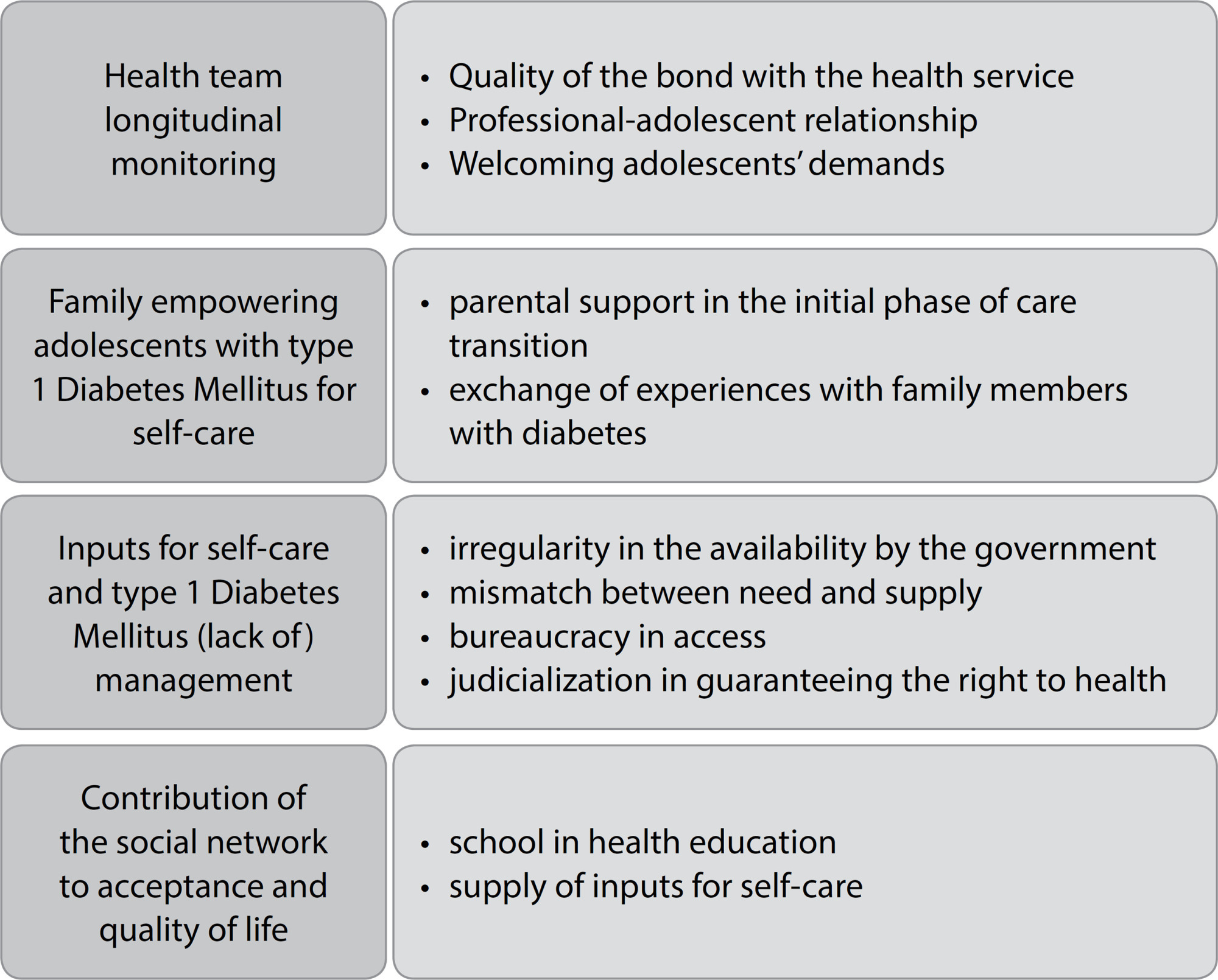
-
ARTÍCULO ORIGINAL09/07/2021
Trend and factors associated with Tuberculosis-Diabetes Mellitus comorbidity in a Northeastern Brazilian municipality
Revista Brasileira de Enfermagem. 2021;74(3):e20201238
Resumen
ARTÍCULO ORIGINALTrend and factors associated with Tuberculosis-Diabetes Mellitus comorbidity in a Northeastern Brazilian municipality
Revista Brasileira de Enfermagem. 2021;74(3):e20201238
DOI 10.1590/0034-7167-2020-1238
Visualizações0Ver maisABSTRACT
Objectives:
to identify the trend and factors associated with Tuberculosis-Diabetes Mellitus comorbidity in Imperatriz, Maranhão.
Methods:
epidemiological temporal-series study, conducted in a Northeastern Brazilian municipality. The population consisted of Tuberculosis cases with Diabetes Mellitus-associated aggravation notified in the Notifiable Diseases Information System (SINAN) between 2009 and 2018. We determined the prevalence and trend of comorbidity using Prais-Winsten regressions and to identify associated factors employed Poisson regression.
Results:
prevalence ranged from 3.23% in 2014 to 19.51% in 2018, with a mean of 11.5% for the period, showing an increasing trend. Age groups 30 to 59 years and ≥ 60 years, education < 8 years, and clinical form of pulmonary Tuberculosis were risk factors for comorbidity.
Conclusions:
The increasing trend of comorbidity and its associated factors alert us to the need to improve customer service at all levels of health care.
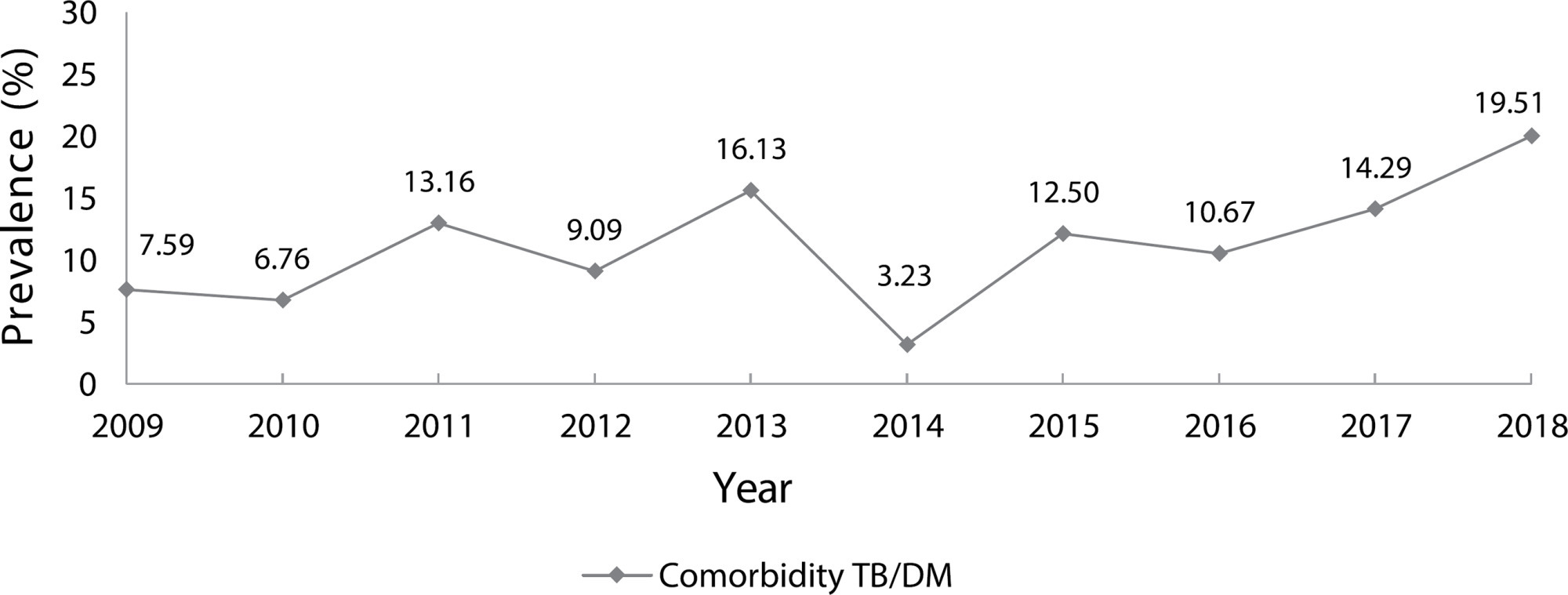
-
09/07/2021
Mortality in community-dwelling elderly: coefficient and associated factors
Revista Brasileira de Enfermagem. 2021;74:e20200612
Resumen
Mortality in community-dwelling elderly: coefficient and associated factors
Revista Brasileira de Enfermagem. 2021;74:e20200612
DOI 10.1590/0034-7167-2020-0612
Visualizações0Ver maisABSTRACT
Objective:
Analyze the coefficient, associated factors, and causes of mortality in community-dwelling elderly.
Method:
Longitudinal and analytical study. Data collection, at baseline, was performed in the elderly’s home. The first wave occurred after 42 months. Complementary data collection identified the cause of death. Variables analyzed: demographic, social, economic, and clinical. Logistic regression was used for data analysis.
Results:
The coefficient of mortality was 7.9%. The variables associated with mortality were longevity, inability to read, absence of religious practice, stroke, consultation, and hospitalization in the last 12 months. The main groups of primary causes of death were ill-defined and unspecified causes of mortality, respiratory system diseases, and neoplasms.
Conclusion:
The coefficient of mortality in community-dwelling elderly was lower than national and international studies investigated.
-
09/07/2021
Algorithm for transitional care for caregivers of dependent older adults: a validation study
Revista Brasileira de Enfermagem. 2021;74:e20200625
Resumen
Algorithm for transitional care for caregivers of dependent older adults: a validation study
Revista Brasileira de Enfermagem. 2021;74:e20200625
DOI 10.1590/0034-7167-2020-0625
Visualizações0Ver maisABSTRACT
Objective:
To construct and validate an algorithm for transitional care for caregivers of dependent older adults.
Method:
This was a methodological study developed in three phases: a literature review, designing an algorithm, and its validation by a peer panel with twenty-seven experts selected according to pre-defined inclusion criteria.
Results:
The algorithm predicted interventions in transitional care (hospital stay, at discharge, and 30 days at home post-discharge) aimed at the exercise of the caregiver role; needs assessment; training in care management of dependent older adults and management of self-care, and ensuring continuity of care (of older adults and caregivers).
Conclusion:
Agreement between expert raters and a reliability test of 0.92 indicate that the algorithm can be used by professionals to decide the transitional care interventions to be administered to the caregivers of dependent older adults. Future studies should be conducted to perform its clinical validation.

-
09/07/2021
Sexuality is associated with the quality of life of the elderly!
Revista Brasileira de Enfermagem. 2021;74:e20201272
Resumen
Sexuality is associated with the quality of life of the elderly!
Revista Brasileira de Enfermagem. 2021;74:e20201272
DOI 10.1590/0034-7167-2020-1272
Visualizações0Ver maisABSTRACT
Objective:
to analyze the association between sexuality and quality of life of Brazilian elderly residents in the community.
Methods:
a cross-sectional study conducted with 477 Brazilian elderly. The data were collected between August and October 2020. We used the EVASI and WHOQOL-OLD (World Health Organization Quality of Life). Data analysis was performed with Mann-Whitney, Spearman and Kruskal-Wallis correlation tests, with Bonferroni post-hoc application when necessary, considering a 95% confidence interval.
Results:
there was a statistical association between all dimensions of sexuality and the general quality of life of the elderly (p<0.05).
Conclusion:
the stimulation of sexuality can be configured as an innovative and holistic strategy focused on the promotion of health and active aging, since this study found the association between sexuality and the general quality of life of elderly people.
-
ARTÍCULO ORIGINAL01/07/2020
Quality of life and osteomuscular symptoms in workers of primary health care
Revista Brasileira de Enfermagem. 2020;73(5):e20190054
Resumen
ARTÍCULO ORIGINALQuality of life and osteomuscular symptoms in workers of primary health care
Revista Brasileira de Enfermagem. 2020;73(5):e20190054
DOI 10.1590/0034-7167-2019-0054
Visualizações1Ver maisABSTRACT
Objectives:
to evaluate the quality of life and musculoskeletal symptoms in primary care workers.
Methods:
descriptive, correlational and cross-sectional study with 85 workers using the WHOQOL-Bref and Nordic Osteomuscular Symptoms Questionnaire.
Results:
lower quality of life for the Environment domain and higher for Social Relationships. Workers reported pain in lower back, neck, shoulders, wrists/hands/fingers and knees. Neck pain influenced Physical (p=0.015) and Psychological (p=0.030) domains; shoulder pain (p=0.004) and dorsal region (p=0.013) influenced the Physical domain; pain in knees influenced Physical (p=0.000) and Environment (p=0.032) domains; pain in the ankles/feet influenced Physical (p=0.000), Psychological (p=0.032) and Environment (p=0.007) domains; pain in the dorsal region influenced the Physical domain (p=0.013).
Conclusions:
workers evaluated their quality of life as good or very good and reported to be satisfied or very satisfied with their health. They also reported pains in lower back, neck, shoulders, wrists/hands/fingers and knees. Pain has influenced the quality of life.

-
ARTÍCULO ORIGINAL06/07/2020
Adult’s perception of health care after myocardial infarction
Revista Brasileira de Enfermagem. 2020;73(5):e20190074
Resumen
ARTÍCULO ORIGINALAdult’s perception of health care after myocardial infarction
Revista Brasileira de Enfermagem. 2020;73(5):e20190074
DOI 10.1590/0034-7167-2019-0074
Visualizações0Ver maisABSTRACT
Objectives:
to describe the Adult’s perception of healthcare after Myocardium Infarction.
Methods:
qualitative descriptive analysis carried out with 12 adults who had myocardial infarction and conducted from February to May 2018. The research design was based on the “Consolidated Criteria for Reporting Qualitative Research”. Data collection was performed through semi-structured questionnaire, interview script and field diary. The interviews were encoded, and their content was analyzed using software support.
Results:
three classes were obtained: “Fear, (un) certainty and (un) awareness”; “Lifestyle and beliefs of illness” and “Health care search”. Unhealthy lifestyle habits, lack of health prevention / promotion, difficulties in accessing services and lack of knowledge about the disease generated fear and uncertainty about the future.
Final Considerations:
the perception of acute myocardial infarction is related to the trajectory of illness, lifestyle and the belief that the infarction only affects others.
-
ARTÍCULO ORIGINAL06/07/2020
In vivo exposure for fear of pain and avoidance of movement in low back pain
Revista Brasileira de Enfermagem. 2020;73(5):e20190125
Resumen
ARTÍCULO ORIGINALIn vivo exposure for fear of pain and avoidance of movement in low back pain
Revista Brasileira de Enfermagem. 2020;73(5):e20190125
DOI 10.1590/0034-7167-2019-0125
Visualizações0Ver maisABSTRACT
Objectives:
to verify the effects of hierarchization and in vivo exposure for fear of pain, avoidance of movement, and anxiety in chronic low back pain.
Methods:
quasi-experimental study. The 27 patients who participated graded the damage associated with the movements in each of the 40 activities of daily living depicted in pictures using a scale from 0 to 100. The patients chose five out of all the activities that received a score higher than 50 to carry out the exposure. The intensities of fear and anxiety were measured before and after each exposure session.
Results:
the frequencies of the gender were equal, and the mean age was 44.9 years. The activities chosen more frequently for the exposure were shoveling (33.3%) and running (33.3%). There was reduction of fear and anxiety before and after exposure (p<0.001).
Conclusions:
hierarchization and in vivo exposure were effective in reducing fear and anxiety.
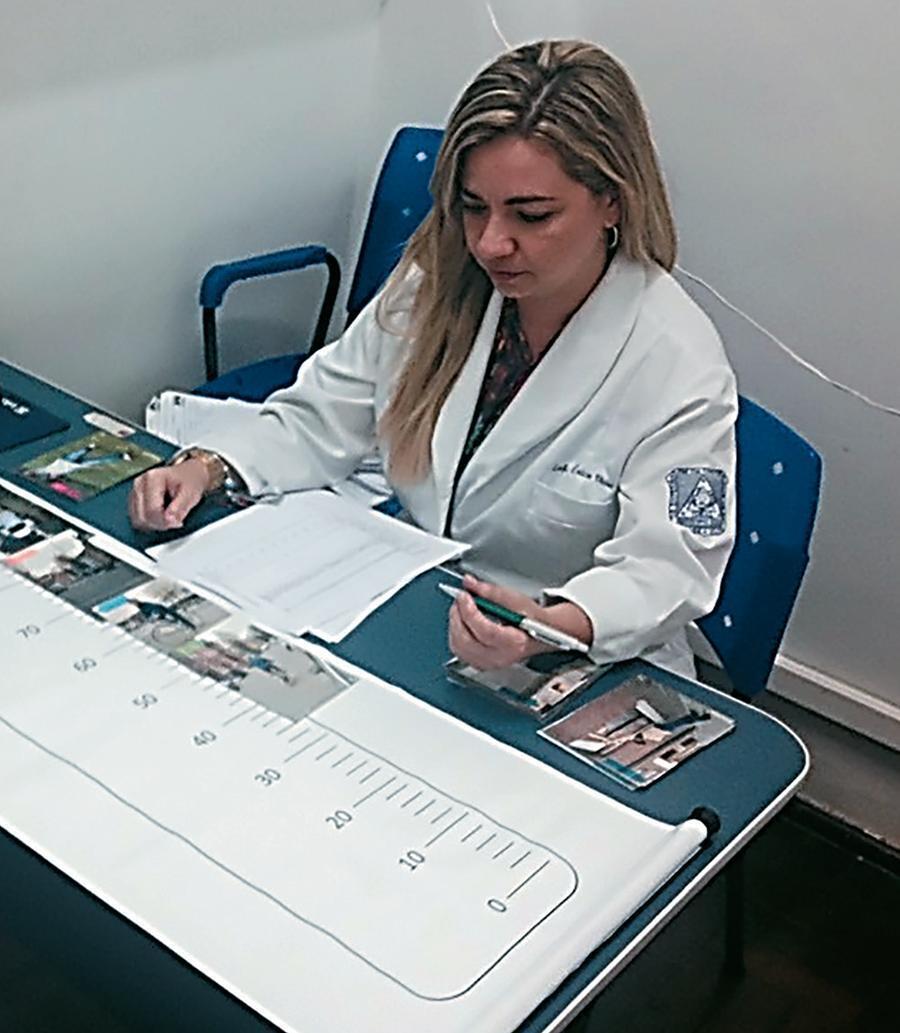
-
ARTÍCULO DE REVISIÓN06/07/2020
Patient safety challenges in primary health care: a scoping review
Revista Brasileira de Enfermagem. 2020;73(5):e20190209
Resumen
ARTÍCULO DE REVISIÓNPatient safety challenges in primary health care: a scoping review
Revista Brasileira de Enfermagem. 2020;73(5):e20190209
DOI 10.1590/0034-7167-2019-0209
Visualizações1Ver maisABSTRACT
Objectives:
to identify the patient safety challenges described by health professionals in Primary Health Care.
Methods:
a scoping review was conducted on the LILACS, MEDLINE, IBECS, BDENF, and CINAHL databases, and on the Cochrane, SciELO, Pubmed, and Web of Science libraries in January 2019. Original articles on patient safety in the context of Primary Health Care by health professionals were included.
Results:
the review included 26 studies published between 2002 and 2019. Four categories resulted from the analysis: challenges of health professionals, administration challenges of health services, challenges with the patient and family, and the potential enhancing resources for patient safety.
Conclusions:
patient safety challenges for Primary Care professionals are multiple and complex. This study provides insight into resources to improve patient safety for health care professionals, patients, administrators, policy makers, educators, and researchers.
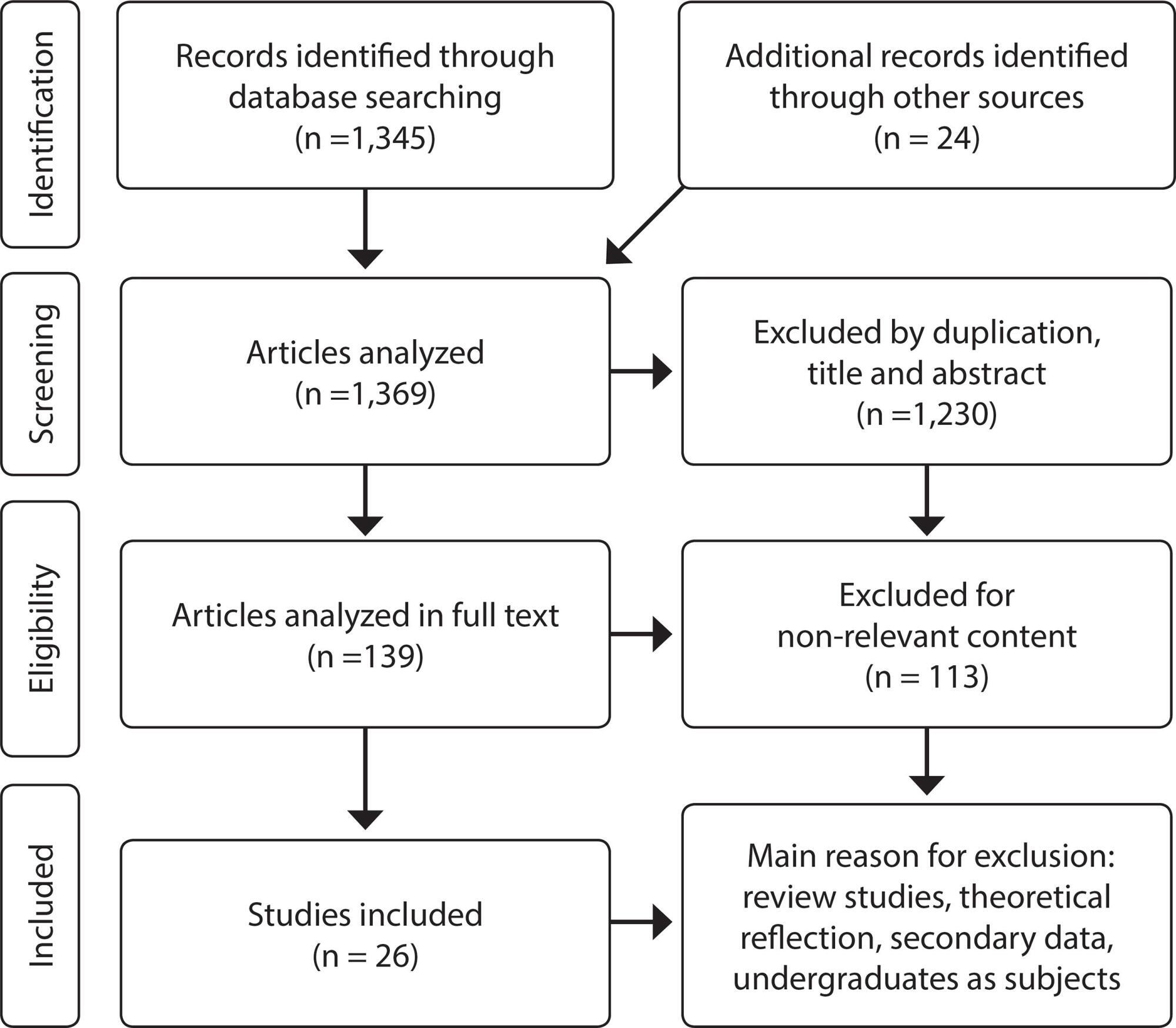
-
ARTÍCULO ORIGINAL08/07/2020
Nurses’ practice in quilombola communities: an interface between cultural and political competence
Revista Brasileira de Enfermagem. 2020;73(5):e20190433
Resumen
ARTÍCULO ORIGINALNurses’ practice in quilombola communities: an interface between cultural and political competence
Revista Brasileira de Enfermagem. 2020;73(5):e20190433
DOI 10.1590/0034-7167-2019-0433
Visualizações1Ver maisABSTRACT
Objectives:
to understand Family Health Strategy nurses’ practices in the context of quilombola communities with an interface for cultural and political competences.
Methods:
a single integrated, qualitative case study carried out on seven Family Health Strategies located in the Metropolitan Region of Belo Horizonte, state of Minas Gerais. Seven nurses and 59 quilombolas participated. Data were collected through individual interviews with nurses, collective interviews with quilombolas and observation. For analysis, the thematic content analysis was adopted.
Results:
the results revealed structural and territorial problems, which are configured as barriers for professional-user encounter as well as for professional practice performance.
Final Considerations:
it is necessary that Family Health Strategy nurses, based on political and cultural competences, create strategies that minimize the difficulties found in the implementation of health actions directed to quilombolas. Such strategies anchored in inclusive public policies.
-
ARTÍCULO ORIGINAL08/07/2020
No to distance education! Production of meaning of discourses of nursing representative entities
Revista Brasileira de Enfermagem. 2020;73(5):e20190465
Resumen
ARTÍCULO ORIGINALNo to distance education! Production of meaning of discourses of nursing representative entities
Revista Brasileira de Enfermagem. 2020;73(5):e20190465
DOI 10.1590/0034-7167-2019-0465
Visualizações0Ver maisABSTRACT
Objectives:
to analyze the processes of production of meanings, based on the positions of Brazilian nursing representative entities, on distance education, considering the implications for nursing as a discipline, profession and work.
Methods:
this documentary research was carried out in sources from the Federal Nursing Council and Associação Brasileira de Enfermagem, from 2015 to 2018. Data were examined from discourse analysis, using paraphrase and polysemy as analytical devices.
Results:
they were organized based on the effects of meanings produced and affiliated to two analytical categories: “Forms of mobilization and operating entities” and “Basis and justifications for the positions”.
Final Considerations:
the discourses signal concern about the future training of new professionals. Resistance, participation, visibility, broad and emphatic debate on the topic are shown as strategies for coping and defending a training process less captured by neoliberal logic, and more relational and committed to the quality of health care.
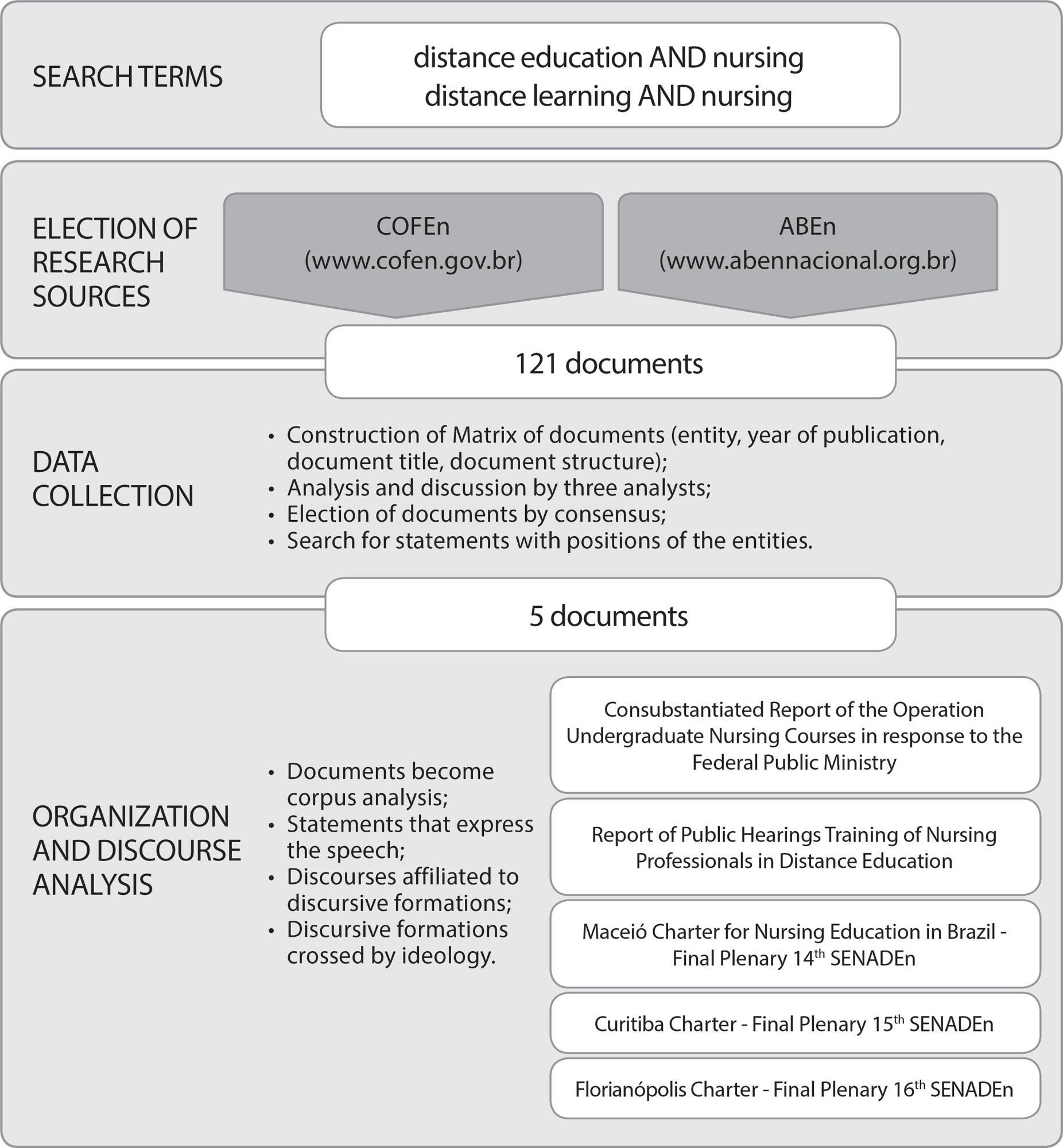
-
ARTÍCULO ORIGINAL13/07/2020
Culture of patient safety in hospital units of gynecology and obstetrics: a cross-sectional study
Revista Brasileira de Enfermagem. 2020;73(5):e20190576
Resumen
ARTÍCULO ORIGINALCulture of patient safety in hospital units of gynecology and obstetrics: a cross-sectional study
Revista Brasileira de Enfermagem. 2020;73(5):e20190576
DOI 10.1590/0034-7167-2019-0576
Visualizações0Ver maisABSTRACT
Objectives:
to assess the patient safety culture of the health team working in three maternity hospitals.
Methods:
observational, cross-sectional, comparative study. 301 professionals participated in the study. The Hospital Survey on Patient Safety Culture questionnaire validated in Brazil was used. For data analysis, it was considered a strong area in the patient safety culture when positive responses reached over 75%; and areas that need improvement when positive responses have reached less than 50%. To compare the results, standard deviation and thumb rule were used.
Results:
of the 12 dimensions of patient safety culture, none obtained a score above 75%, with nine dimensions scoring between 19% and 43% and three dimensions between 55% and 57%.
Conclusions:
no strong dimensions for safety culture were identified in the three maternity hospitals. It is believed that these results may contribute to the development of policies that promote a culture of safety in institutions.
-
01/07/2020
Impressão de idosos polimedicados sobre o serviço farmacêutico
Revista Brasileira de Enfermagem. 2020;73(5):e20190305
Resumen
Impressão de idosos polimedicados sobre o serviço farmacêutico
Revista Brasileira de Enfermagem. 2020;73(5):e20190305
DOI 10.1590/0034-7167-2019-0305
Visualizações1Ver maisRESUMEN
Objetivos:
Describir la importancia de las indicaciones brindadas durante la consulta farmacéutica sobre la adhesión al tratamiento farmacológico según discursos de ancianos polimedicados.
Métodos:
estudio metodológico, cualitativo, realizado durante consultas con 40 pacientes ancianos de ambos sexos en el Centro de Atención de Salud de Ancianos y Cuidadores. Se utilizó análisis de contenido, con un cuestionario de dos preguntas abiertas.
Resultados:
Surgieron dos categorías y ocho subcategorías tras la transcripción de discursos y la lectura exhaustiva de datos. La categoría “Consulta farmacéutica como instrumento educativo para el autocuidado de ancianos polimedicados” expresó la mayor frecuencia. La subcategoría más frecuente fue “Preocupación de los ancianos por el autocuidado”.
Consideraciones finales:
En el caso de pacientes mayores polimedicados, la consulta farmacéutica constituye un importante instrumento educativo que, a través de la provisión de indicaciones farmacéuticas, permite minimizar las preocupaciones respecto de la farmacoterapia, contribuyendo así al cumplimiento y al autocuidado.
-
ARTÍCULO ORIGINAL18/08/2021
Effects of floral therapy on labor and birth: a randomized clinical trial
Revista Brasileira de Enfermagem. 2021;74:e20210079
Resumen
ARTÍCULO ORIGINALEffects of floral therapy on labor and birth: a randomized clinical trial
Revista Brasileira de Enfermagem. 2021;74:e20210079
DOI 10.1590/0034-7167-2021-0079
Visualizações0INTRODUCTIONThe Policy of Comprehensive Attention to Women’s Health focuses on improving obstetric care. One of the points observed in the Program of Comprehensive Attention to Women’s Health is the monitoring of pacts to reduce the rate of cesarean sections in hospitals of the Brazilian Unified Health System (SUS – Sistema Único de Saúde), rescuing the […]Ver mais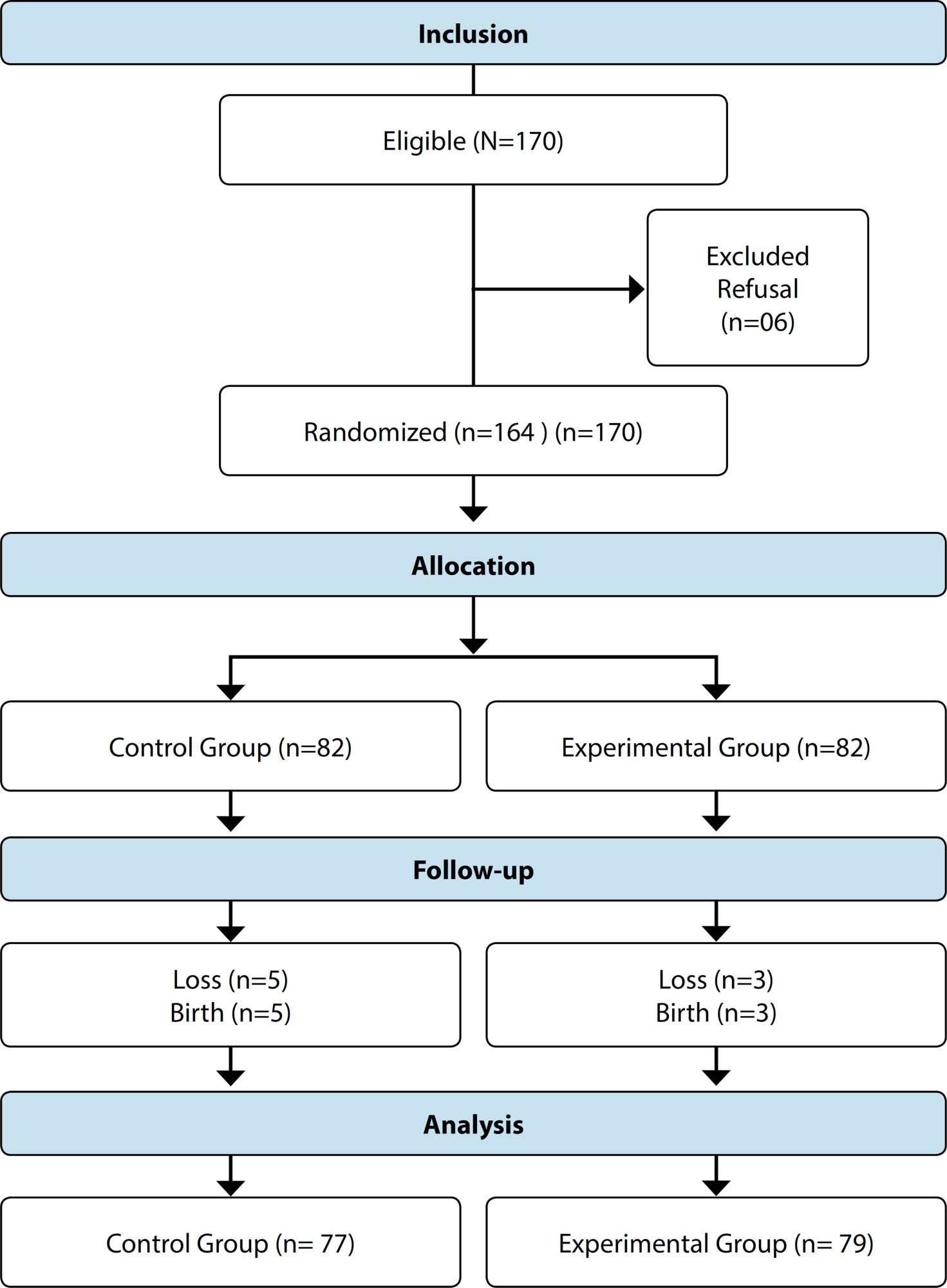
-
REFLEXIÓN21/10/2019
Supervisão Clínica e preceptoria/tutoria – contribuições para o Estágio Curricular Supervisionado
Revista Brasileira de Enfermagem. 2019;72(6):1730-1735
Resumen
REFLEXIÓNSupervisão Clínica e preceptoria/tutoria – contribuições para o Estágio Curricular Supervisionado
Revista Brasileira de Enfermagem. 2019;72(6):1730-1735
DOI 10.1590/0034-7167-2018-0785
Visualizações0Ver maisRESUMO
Objetivo:
Refletir sobre as contribuições da supervisão clínica e da preceptoria/tutoria como meios para a aproximação e envolvimento dos enfermeiros dos serviços de saúde nas atividades de Estágio Curricular Supervisionado, discutindo enfoques conceituais, teóricos e práticos para o ensino superior em enfermagem.
Método:
Trata-se de estudo reflexivo fundamentado na formulação discursiva acerca da supervisão clínica e da preceptoria/tutoria.
Resultados:
a supervisão clínica tem sido amplamente utilizada pelas instituições de saúde internacionais para qualificar os processos de trabalho dos enfermeiros, apoiando seu autodesenvolvimento. Atualmente tem fundamentado a atuação do enfermeiro preceptor/tutor que acompanha estudantes na realização de estágios clínicos.
Considerações finais:
A supervisão clínica de estudantes de enfermagem se apresenta como estratégia robusta e eficaz para o desenvolvimento do estudante em estágio e para a efetivação da integração ensino-serviço.
-
ARTÍCULO ORIGINAL10/07/2020
Nursing appeals on social media in times of coronavirus
Revista Brasileira de Enfermagem. 2020;73:e20200225
Resumen
ARTÍCULO ORIGINALNursing appeals on social media in times of coronavirus
Revista Brasileira de Enfermagem. 2020;73:e20200225
DOI 10.1590/0034-7167-2020-0225
Visualizações0Ver maisABSTRACT
Objective:
to know and analyze the nursing appeals on social media during the COVID-19 pandemic.
Method:
it is a documentary, qualitative, descriptive, and exploratory research with data collected in publications in two social media. Two hundred ninety-five publications of nursing professionals published on Twitter and Instagram between March 11 and 20, 2020 were submitted to content analysis using ATLAS.ti resources.
Results:
four thematic categories emerged: #stayathome, #whereismyPPE, #nowweareheroes, #nothingnewinthefrontline, according to frequency of communications. The appeals show a relationship with the social relevance of nursing professional work and with the conditions required for its exercise.
Final considerations:
old and new challenges of the profession were placed on the agenda in social media, especially related to the workforce and instruments of labor. These speeches can serve as a foundation for policies to improve working conditions and promote appreciation of the profession.

-
REFLEXIÓN29/06/2020
Children’s (in)visibility in social vulnerability and the impact of the novel coronavirus (COVID-19)
Revista Brasileira de Enfermagem. 2020;73:e20200302
Resumen
REFLEXIÓNChildren’s (in)visibility in social vulnerability and the impact of the novel coronavirus (COVID-19)
Revista Brasileira de Enfermagem. 2020;73:e20200302
DOI 10.1590/0034-7167-2020-0302
Visualizações0Ver maisABSTRACT
Objective:
To examine the impact of the infection by the novel coronavirus on Brazilian children in situation of social vulnerability based on the Millennium Sustainable Development Goals.
Method:
Reflective study based on discursive formulation in three aspects: principles of the objectives and goals for the millennium sustainable development; impact of the pandemic on the health of children and their families living in social vulnerability; and the role of pediatric nursing in the care provided – limits and challenges.
Results:
In January 2020, the news of COVID 19 is released as a pandemic. In Brazil, children and families are still without access to basic rights, thereby increasing their risks of social vulnerability because of the quarantine. The nursing field has an important role in monitoring children and their families, offering guidance in search for solutions and preventing contamination.
Conclusion:
There are still challenges to be overcome by the children and their families in situations of vulnerability against COVID-19.
-
ARTÍCULO ORIGINAL21/10/2019
Desafios da prática na segurança do paciente
Revista Brasileira de Enfermagem. 2019;72(6):1504-1511
Resumen
ARTÍCULO ORIGINALDesafios da prática na segurança do paciente
Revista Brasileira de Enfermagem. 2019;72(6):1504-1511
DOI 10.1590/0034-7167-2018-0441
Visualizações0RESUMO
Objetivo:
compreender os desafios da prática profissional para o alcance das metas e objetivos do Programa Nacional de Segurança do Paciente.
Método:
estudo de caso qualitativo, fundamentado na Sociologia Compreensiva, realizado com 31 profissionais do Núcleo de Segurança do Paciente e da equipe de enfermagem, que trabalhavam em um hospital de ensino. A coleta de dados ocorreu entre maio e dezembro de 2015 por meio de entrevistas, observação e análise documental. A análise procedeu conforme as prerrogativas da Análise de Conteúdo.
Resultados:
emergiram três categorias, sendo elas: A realidade prescrita; Os recursos materiais e seus impactos no cuidado; e A realidade relacionada aos recursos humanos.
Considerações finais:
os desafios para a prática profissional segura perpassam pela estrutura física inadequada, insuficiência de recursos materiais e humanos, mas, principalmente, invadem a transição das mudanças no âmbito prescritivo para o real.
Palavras-chave: EnfermagemHospitaisPrática ProfissionalQualidade da Assistência à SaúdeSegurança do PacienteVer mais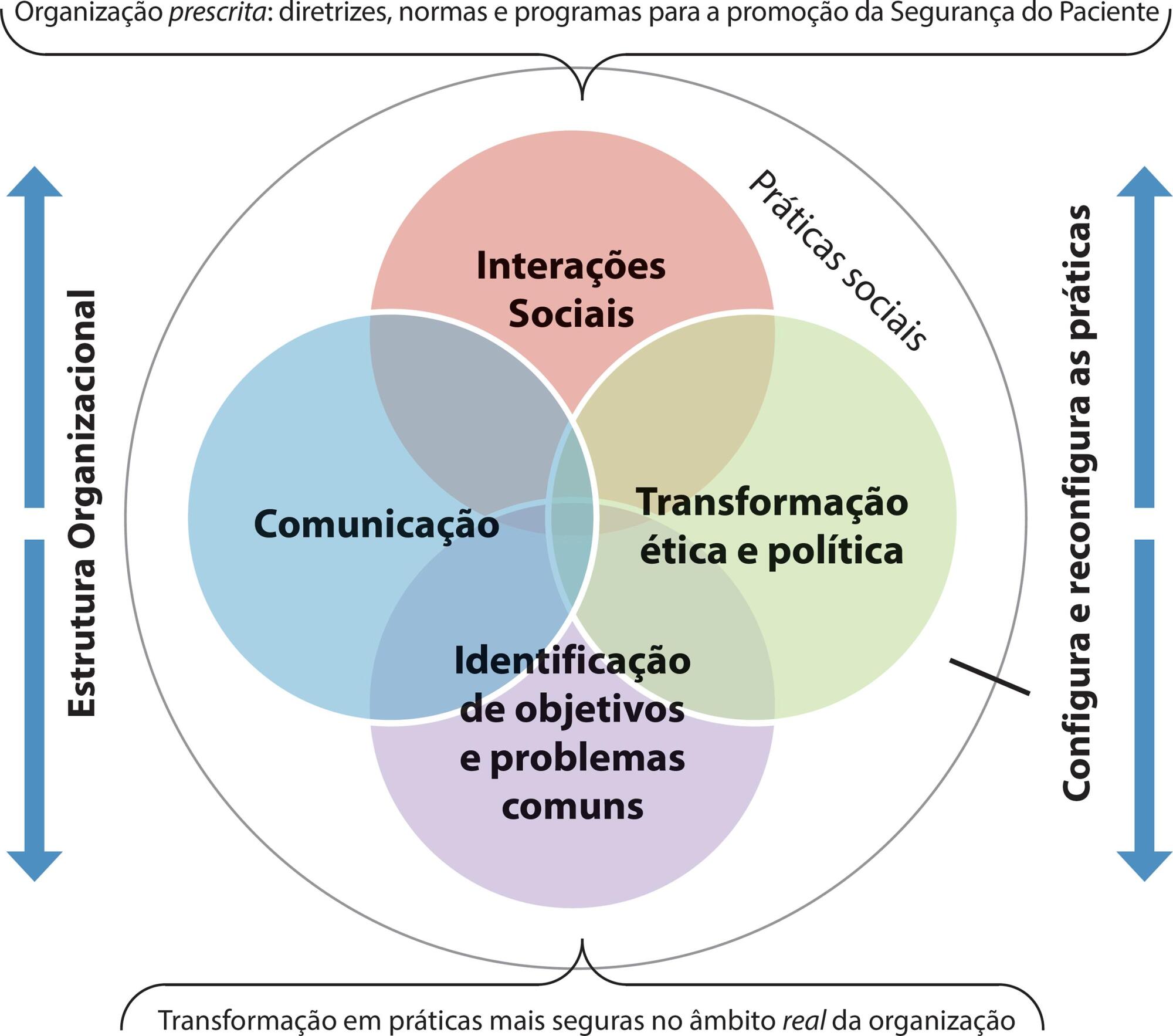
-
ARTÍCULO ORIGINAL21/10/2019
Avaliação do burnout em enfermeiros de um serviço de urgência geral
Revista Brasileira de Enfermagem. 2019;72(6):1457-1463
Resumen
ARTÍCULO ORIGINALAvaliação do burnout em enfermeiros de um serviço de urgência geral
Revista Brasileira de Enfermagem. 2019;72(6):1457-1463
DOI 10.1590/0034-7167-2017-0870
Visualizações0RESUMO
Objetivo:
Avaliar o nível de Burnout dos enfermeiros de um serviço de urgência geral.
Método:
Estudo quantitativo, descritivo, correlacional e transversal. Participaram 32 enfermeiros de um serviço de urgência geral de adultos que responderam a um questionário para avaliar o Burnout. (Copenhagen Burnout Inventory).
Resultados:
Verificou-se que 59,4% dos enfermeiros estavam em Burnout Total, sendo o Burnout relacionado com o trabalho, a dimensão com valor mais elevado. Apurou-se que quanto menor a idade, quanto mais tempo na instituição, maior o nível de Burnout. Quanto mais tempo de exercício profissional, menor o Burnout. Verificou-se ainda valores mais elevados de Burnout nos participantes que pensam em mudar de profissão, nos que pensam em mudar de instituição e mudar de serviço.
Conclusão:
A prevalência de Burnout é elevada. O Burnout profissional é a dimensão mais prejudicada. A idade e o contexto de exercício são as dimensões que mais influenciam a perceção de Burnout.
Palavras-chave: Condições de TrabalhoEmergênciasEnfermagemEsgotamento ProfissionalEstresse PsicológicoVer mais -
ARTÍCULO ORIGINAL19/08/2019
Aplicativo móvel para ensino da Classificação Internacional para a Prática de Enfermagem
Revista Brasileira de Enfermagem. 2019;72(4):1020-1027
Resumen
ARTÍCULO ORIGINALAplicativo móvel para ensino da Classificação Internacional para a Prática de Enfermagem
Revista Brasileira de Enfermagem. 2019;72(4):1020-1027
DOI 10.1590/0034-7167-2018-0751
Visualizações0RESUMO
Objetivo:
Desenvolver um aplicativo móvel para o ensino da Classificação Internacional para a Prática de Enfermagem.
Métodos:
Estudo metodológico aplicado, de produção tecnológica, realizado em três fases do modelo de design instrucional contextualizado: análise, design e desenvolvimento.
Resultados:
O aplicativo possui uma tela inicial, na qual são fornecidas informações sobre a equipe e o tópico de ajuda. Em seguida, são listados quatro moblets, que versam sobre apresentação, guia do usuário constituído por cinco módulos, jogos educativos e cinco casos clínicos. Também são dispostas as referências utilizadas para a construção do aplicativo.
Considerações finais:
Foi possível desenvolver o aplicativo com potencial para impulsionar estudantes e profissionais de enfermagem a ter um melhor conhecimento sobre o referido sistema de classificação.
Palavras-chave: EnfermagemInformática em EnfermagemProcesso de EnfermagemTecnologia EducacionalTerminologia Padronizada em EnfermagemVer mais
-
ARTÍCULO ORIGINAL10/07/2020
Perfil dos estudantes que cursam enfermagem: qualidade de vida, sono e hábitos alimentares
Revista Brasileira de Enfermagem. 2020;73:e20190365
Resumen
ARTÍCULO ORIGINALPerfil dos estudantes que cursam enfermagem: qualidade de vida, sono e hábitos alimentares
Revista Brasileira de Enfermagem. 2020;73:e20190365
DOI 10.1590/0034-7167-2019-0365
Visualizações0RESUMO
Objetivo:
traçar o perfil e analisar a qualidade do sono, qualidade de vida e hábitos alimentares dos estudantes de enfermagem.
Métodos:
estudo transversal, comparativo e correlacional com as seguintes variáveis: características sociodemográficas, índice de qualidade de sono de Pittsburgh, qualidade de vida e hábitos alimentar. 195 estudantes participaram do estudo.
Resultados:
os participantes tinham em média 24 anos. Os resultados demonstraram que o sexo feminino foi prevalente (87,1%); 71,0% dos estudantes apresentaram qualidade de sono ruim; 98,9% faziam uso de aparelhos eletrônicos antes de dormir. A autopercepção da qualidade de vida foi indiferente (38,3%) e quanto à autopercepção de saúde geral, 36,9% expressaram-se satisfeitos. Dentre os participantes, 45,13% consumiam uma porção de fruta e 40,66% duas a três porções de verduras e legumes, diariamente.
Conclusão:
o estudo permitiu traçar o perfil desses estudantes, jovens que estudavam e trabalhavam, sedentários, acima do peso e com qualidade de sono ruim.
Palavras-chave: Comportamento AlimentarEstudantes de EnfermagemInquéritos e QuestionáriosQualidade de VidaSonoVer mais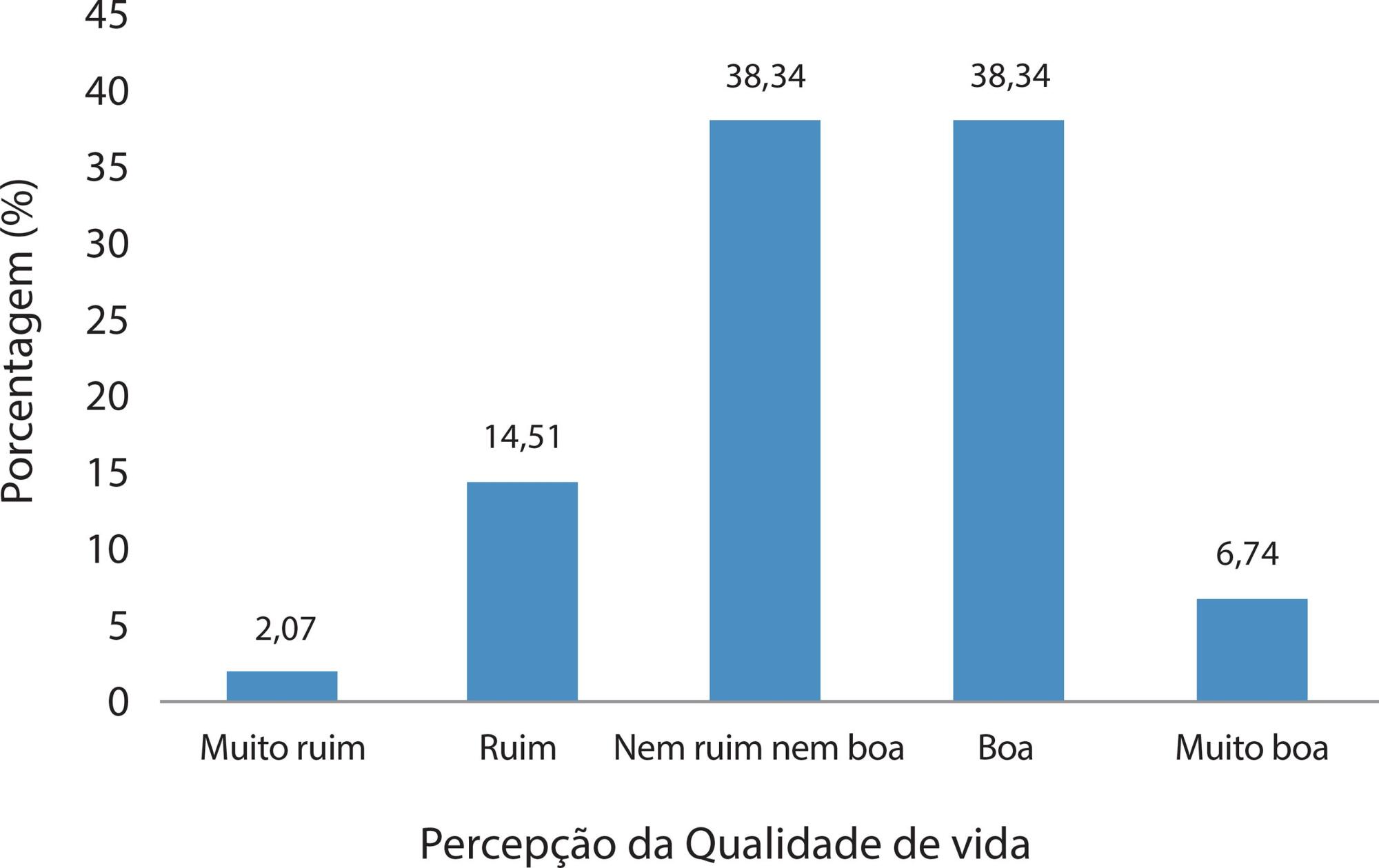
Búsqueda
Buscar en:
Nuvem de Tags
Adolescente (85) Atenção Primária à Saúde (239) COVID-19 (91) Criança (91) Cuidados de Enfermagem (269) Educação em Enfermagem (151) Educação em Saúde (139) Enfermagem (930) Enfermagem Pediátrica (86) Estudantes de Enfermagem (77) Estudos de Validação (131) Família (87) Idoso (208) Promoção da Saúde (99) Qualidade de Vida (104) Saúde do Trabalhador (86) Saúde Mental (145) Saúde Pública (82) Segurança do Paciente (150) Tecnologia Educacional (100)



